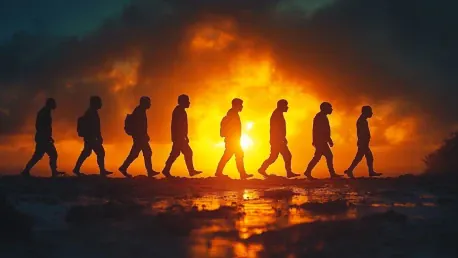Human evolution has always captured our imagination, leading to discoveries that continuously reshape our understanding of our origins. Researchers at the University of Cambridge have made a significant breakthrough, revealing that all modern humans share DNA from two ancient populations. These populations split 1.5 million years ago and later reunited, influencing the genetic makeup of every human today. The groundbreaking study, published in Nature Genetics, uncovers a more complex history of human evolution that has left indelible genetic imprints on all people alive today.
Shared Ancestry of Modern Humans
The Cambridge study, spearheaded by researchers Trevor Cousins, Aylwyn Scally, and Richard Durbin, found that modern human DNA is composed of approximately 80% from one ancient population and about 20% from another. This means that regardless of ethnicity or geographical location, all humans share the genetic legacy of these two primordial groups. This discovery offers profound insights into human evolution, presenting a past marked by intricate separations and subsequent reunions of ancient human populations, well before the emergence of anatomically modern humans.
Prior models of human evolution often depicted a relatively straightforward progression, but the study indicates a far more complex scenario. The research suggests that these ancient populations evolved separately for over a million years before merging around 300,000 years ago. This ancient interbreeding event is foundational to the genetic diversity observed in contemporary human populations, painting a richer, more interconnected picture of our evolutionary history.
Innovative Techniques and Tools
The breakthrough was facilitated by the development of a novel computational tool known as “cobraa” (coalescence-based reconstruction of ancestral admixture). Cambridge researchers employed this tool to analyze DNA patterns and identify historical population separations and mixing events. Cobraa works by examining genetic similarities and differences distributed across an individual’s genome, which enables scientists to reconstruct population histories in great detail.
Using cobraa, the team discovered a major interbreeding event that occurred around 300,000 years ago. This period coincides with the earliest appearance of anatomically modern humans in the fossil record. The tool’s ability to pinpoint such critical events in evolutionary history revolutionizes our understanding of human evolution, highlighting the deep ancestral connections that unite all modern humans.
Structural Complexity in Human Ancestry
Traditionally, human evolution was understood as a relatively linear process, with distinct separations between different groups. However, the new findings from the Cambridge study reveal a far more intricate evolutionary history. Human groups evolved separately for over a million years before reuniting, adding depth and complexity to our understanding of genetic diversity. This interbreeding event was so profound that it forms the foundation of the genetic variations observed in humans today.
The study challenges the simplification of human evolution into clean, separate lineages, suggesting instead a narrative marked by repeated separations and reunions. These ancient dynamics are reflected in the DNA of modern humans, highlighting the interconnected and dynamic nature of our evolutionary past.
Examining Ancient Populations and Genetic Bottlenecks
After the initial split 1.5 million years ago, the population that eventually contributed to the majority of modern human ancestry experienced a severe bottleneck. This event led to a drastic reduction in population size, significantly decreasing genetic diversity within this lineage. The majority population’s genetic material, favored through natural selection, dominates functionally important regions of our genome today.
Conversely, the genetic contributions from the minority population, forming about 20% of our ancestry, are unevenly distributed across the genome. They tend to be located farther from genes, implying that natural selection favored the genetic material from the majority population in key functional areas. This distribution suggests that the genetic variants from the minority population were less advantageous in the majority’s genetic background, shaping the present-day human genome structure.
Comparing to Neanderthals and Denisovans
Interestingly, the regions of modern human DNA derived from the majority ancient population show less divergence when compared to Neanderthal and Denisovan DNA. This finding underscores the significant ancestral lineage of the majority population to these archaic humans. It reinforces the interconnected nature of human ancestry, revealing intricate relationships between different hominin species.
The study highlights how ancient mixing events have contributed to the genetic tapestry of modern humans, aligning with evidence from Neanderthal and Denisovan genetic studies. These insights emphasize the shared genetic heritage among various human and hominin groups.
Identifying Fossil Records: Who Were They?
While the fossil record includes various human-like species, such as Homo erectus and later Homo heidelbergensis, distinguishing the specific identities of these ancient populations remains speculative. Fossil evidence indicates coexistence and interaction among these species roughly 1.5 million years ago. The detected genetic bottleneck might correspond to a founder event related to migration and physical separation, adding complexity to the task of pinpointing specific fossil species to these genetic findings.
The ambiguity in fossil records makes identifying the exact contributors to our genetic makeup challenging. However, ongoing research and advancements in DNA analysis continue to refine our understanding of these ancient populations and their impact on modern human genetics.
Wider Implications for Our Understanding of Evolution
The study’s revelations challenge traditional, linear models of human evolution, suggesting instead a history marked by repeated separations and reunions. This dynamic nature of human evolution reflects the complexity and interconnectedness that define our ancestry. Such insights underscore the importance of reevaluating established paradigms and embracing more nuanced perspectives in evolutionary biology.
These findings prompt reexamination of human evolution’s narrative, encouraging researchers to explore the intricate relationships that have shaped our genetic heritage. The study opens new avenues for understanding how ancient interminglings have influenced contemporary human populations.
Patterns Across Species Strengthen Findings
To ensure the robustness of their discoveries, the Cambridge researchers applied their cobraa model to other species, including bats, dolphins, gorillas, and chimpanzees. They observed considerable variation in ancient structure across these species, affirming the specific patterns found in humans and bolstering the credibility of their findings.
The comparative analysis with diverse species underscores the evolutionary principles governing population separations and mixing events. By examining these patterns across a broad spectrum of organisms, the study provides a comprehensive framework for understanding the complexity of evolutionary histories.
Functional Insights from Genetic Diversity
The detailed analysis revealed significant functional insights into the genetic diversity of modern humans. Genes enriched in minority ancestry often relate to neural development, neuron cell connections, startle responses, and neurotransmitter transport. These genes suggest adaptations to distinct environments prior to the reunion of the ancestral populations and contribute to important biological functions in contemporary humans.
Meanwhile, genes with minimal minority ancestry are frequently involved in RNA processing, cell structure, and immune functions. This distribution indicates that certain genetic variants from each population provided specific biological advantages, which were preserved through natural selection. These patterns offer valuable insights into the adaptive strategies of ancient human populations and their lasting impact on modern human biology.
A Collaborative Effort
This groundbreaking research received funding through a Wellcome Postgraduate Studentship for Trevor Cousins and a Wellcome Investigator Award for Richard Durbin. The funders did not partake in the study’s design, data collection, analysis, publication decisions, or manuscript preparation. The research team comprised Trevor Cousins, Aylwyn Scally, and Richard Durbin from Cambridge’s Department of Genetics, whose collaborative efforts have significantly advanced our understanding of human origins.
The study, “A structured coalescent model reveals deep ancestral structure shared by all modern humans,” published in the prestigious journal Nature Genetics, represents a critical leap forward in unraveling the complex genetic history shared by all modern humans.
Conclusion: A New Chapter in Human Evolution
Human evolution has always fascinated us, leading to discoveries that continually reshape our understanding of our ancestry. The researchers at the University of Cambridge have made a significant breakthrough that reveals all modern humans share DNA from two ancient populations that diverged around 1.5 million years ago and later reunited, influencing the genetic composition of every human being alive today. This groundbreaking study, recently published in Nature Genetics, uncovers a more complex history of human evolution. The research findings indicate that after a split, these ancient populations continued to evolve separately for a significant period before merging again, which created a genetic intermingling. This new genetic information enhances our knowledge of the intricacies involved in human evolution, revealing that modern human DNA carries imprints from a much more complicated ancestry than previously thought. The findings underscore the interconnectedness of all human beings, providing deeper insight into our shared genetic heritage and highlighting the evolutionary events that have shaped us into the species we are today. This discovery is pivotal for comprehending the intricate tapestry of our genetic history, reminding us of the significant events and interactions that have contributed to the diversity of human life on Earth.









